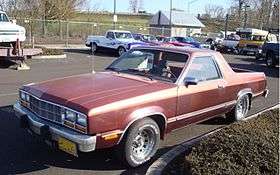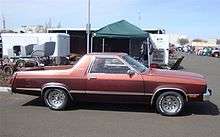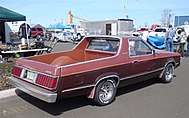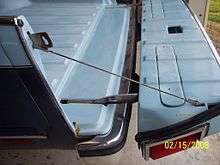Ford Durango
The Ford Durango is a two-passenger coupe utility sold in limited production by Ford Motor Company[1] between the 1979 and 1982 model years. The vehicle was the result of a joint venture between Ford and National Coach Works, located in Los Angeles, California.[2]
| Ford Durango | |
|---|---|
 1981 Ford Durango | |
| Overview | |
| Manufacturer | National Coach Works Ford |
| Production | 1979–1982 |
| Model years | 1979–1982 |
| Assembly | Los Angeles, California (National Coach Works) |
| Body and chassis | |
| Class | Compact |
| Body style | 2-door coupe utility (pickup truck) |
| Layout | FR layout |
| Platform | Ford Fox platform |
| Related | Ford Fairmont Futura |
| Powertrain | |
| Engine | 200 in3 (3.3 L) Thriftpower Six I6 |
| Transmission | 3-speed automatic |
| Chronology | |
| Predecessor | Ford Ranchero |
| Successor | Ford Ranger |
While not officially a production vehicle or a replacement for the Ford Ranchero (which ended production after the 1979 model year), the Durango was designed as a potential competitor to the newly downsized Chevrolet El Camino and was commissioned by Ford to be sold through Ford dealerships. As no official totals were kept by either company production estimates vary between the low 200s and 350, with 212 conversions known to have been made by National Coach Works.[1][3]
Design overview
Production
To produce the Durango, National Coach Works used the body of the Ford Fairmont Futura two-door coupe. Aft of the B-pillar, the roof was removed along with the trunklid and rear seating area. Behind the rear seats, the company added a flat-floor fiberglass cargo bed along with a bulkhead and new rear window behind the two front seats. The rear fascia above the bumper was redesigned into a fold-down tailgate. As the tailgate included the license plate and taillamps, the Durango was produced with a disclaimer warning drivers from driving with the tailgate in the down position.[1][4]
The Pickup, Van and 4WD magazine from December 1981 features an article about the Durango that states: "The project had been planned for an earlier date in 1981 than that which was finally achieved, so only a little over 100 units were assembled before the current-year model went out of production."[5]
 Ford Durango side profile, showing view of original B-pillar
Ford Durango side profile, showing view of original B-pillar Rear 3/4 view, showing fiberglass cargo bed conversion
Rear 3/4 view, showing fiberglass cargo bed conversion
Features

As the B-pillar design of the Fairmont Futura coupe lent itself to the conversion on an unofficial basis, there are several unique features to the Durango that identify it as a vehicle converted by National Coach.[6] With the exception of a prototype based upon a 1979 Mercury Z-7, all examples were based upon the Fairmont Futura.[2] Conversions by National Coach, which are the only versions with a functioning tailgate, feature a fiberglass filler panel between the cargo bed and the tailgate; the design of the panel stores the tailgate hinges when it is folded down.[2]
As equipped from the factory, the Ford Durango was equipped only with a 200 cubic-inch inline six, the mid-range engine of the Fairmont line.[2] The engine was paired with a three-speed automatic transmission.
The Pickup, Van and 4WD magazine from December 1981 features an article about the Durango that states: "The project had been planned for an earlier date in 1981 than that which was finally achieved, so only a little over 100 units were assembled before the current-year model went out of production." Nearly all factory-converted Durangos were produced during the 1981 model year; it is unknown how many 1982 examples were produced.[1][2]
References
- Strohl, Daniel (January 3, 2008). "Ford's last 'chero – the Durango". Hemmings Daily. Retrieved July 14, 2015.
- "1981-1982 Durango: The Should-Have-Been Ranchero Replacement". Collectible Automobile. February 1995.
- Hardigree, Matt (May 15, 2008). "Another Ford Fairmont Durango For Sale, Can You Resist The Foxchero?". Jalopnik. Retrieved August 10, 2016.
- "Durango-the last Ranchero (Looking for other Fairmont Durango owners) | Page 2 | ranchero.us". www.ranchero.us. Retrieved August 9, 2016.
- "Durango". Pickup, Van & 4WD. December 1981.
- Fitzgerald, Craig (January 3, 2014). "Auction Car of the Week: 1981 Ford Durango". BoldRide. Archived from the original on April 26, 2015. Retrieved August 9, 2016.